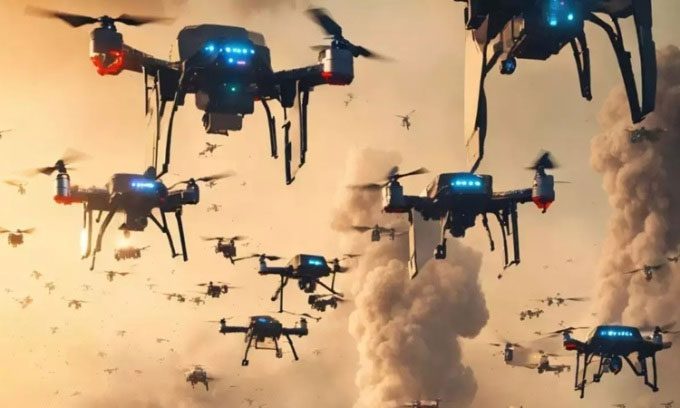Artificial Intelligence (AI) has the potential to transform the landscape of warfare, making conflicts more complex and dangerous than ever before.
Automated Weapons
Robots, drones, torpedoes… all types of weapons can be converted into automated systems thanks to complex sensors managed by AI algorithms that allow computers to “see.” “Automation does not mean that weapons can wake up in the morning and decide to start a war,” explains Stuart Russell, a computer science professor at the University of California, Berkeley. “It means they have the ability to locate, select, and attack human targets, or targets with people present, without human intervention.”

Remote-controlled drones can be deployed en masse in warfare. (Photo: Economic Times).
Most weapons are still in the conceptual or prototype stage, but the conflict between Russia and Ukraine illustrates their potential. Remote-controlled drones are not new, but they are becoming increasingly autonomous and are being utilized by both sides, forcing people underground to seek refuge. This could be one of the most immediate significant changes, according to Russell. “The consequence of using automated weapons is that being visible anywhere on the battlefield will equate to a death sentence,” Russell states.
Automated weapons offer several potential advantages when attacking adversaries. They can operate more efficiently, are cheaper to produce, and eliminate detrimental emotions such as fear or anger that arise from battlefield situations. However, this also raises ethical questions. For instance, if they are cheap and easy to produce, there would be no limits to the firepower a warring side could deploy. They could unleash millions of such weapons at once if they wanted to flatten a city or wipe out a population.
Automated Vehicles
Submarines, ships, and aircraft can operate autonomously, enhancing reconnaissance, surveillance, or logistical support in remote or dangerous environments. Such vehicles are central to the “Replicator” program directed by the Pentagon. The program aims to deploy thousands of cheap and easily replaceable systems across various areas, from the sea to outer space.
Many companies are also developing and testing automated vehicles, such as Anduril in California, which focuses on underwater vehicles optimized for a range of defense and commercial missions, including long-range oceanographic sensors, mining surveys, and anti-submarine operations.
Tactical Software
Powered by AI, tactical software can synthesize vast amounts of data collected from satellites, radar, sensors, and espionage activities, providing planners with a significant advantage. “Everyone at the Department of Defense needs to understand that data is essentially ammunition in AI warfare,” shares Alexandr Wang, CEO of Scale AI. “We have the largest military software system in the world, generating 22 terabytes of data every day. If we can deploy and integrate the data perfectly, we can create a massive advantage when using artificial intelligence in military operations.”
Scale AI has a contract to deploy language models across the highly classified network of a major unit in the U.S. military. A chatbot named “Donovan” allows commanders to plan and act within minutes rather than weeks.





















































